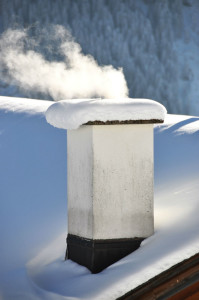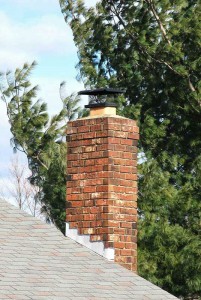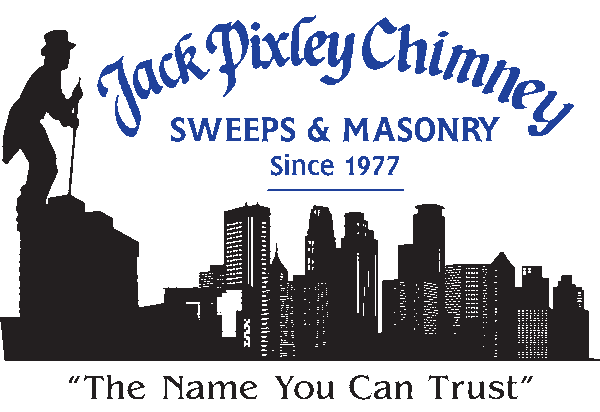The arrival of spring brings warmer temperatures, plenty of green plant growth, and the birth of adorable baby animals. Unfortunately, many animals think chimneys are the perfect nesting spot to protect their new babies from predators and the elements.
While the presence of animals in the chimney may seem like a minor inconvenience – especially if you are not using your fireplace – it can lead to significant chimney damage or expose your family to disease. However, animal entry can be avoided with the use of a chimney cap.
How animals get in
The primary way that animals get into the flue is through a damaged – or missing – chimney cap. Sitting at the top of the chimney, the chimney cap covers and protects the flue from the elements. The metal top and mesh or wire sides allow smoke and gas to safety vent from the fireplace while preventing water, debris, and animals from getting in.
Even minor damage to the chimney cap can create enough space for animals to gain entry to the chimney; small holes in the mesh sides, dents in the metal, or missing screws can all create opportunities for animal entry. While birds and small mammals may only need a few inches to squeeze through, raccoons have been known to claw and bite at weak areas in order to create large enough openings for them to fit through.
How animals damage your chimney
While a chimney might seem like the ideal nesting spot for an animal, the presence of wildlife in the flue can cause significant problems for your chimney system. The following are just a few of the ways animals cause damage to your chimney.
– Chimney cap: Animal entry can worsen damage to a chimney cap. In addition to leaving space for more animals to enter in the future, this can also allow water and debris into the flue year-round.
– Flue liner: Beaks, talons, and claws can all scratch or chip the flue liner as animals attempt to navigate the cramped, dark flue. Likewise, nesting materials may have a corrosive effect on the liner, sometimes requiring chimney relining.
– Debris: Animal houseguests in the chimney do not come empty-handed; nesting materials, food, and droppings can accumulate in the flue. In addition to increasing the risk of chimney fire, this can also exposure your family to bacteria, bugs, and other diseases.
How to keep animals out
The most effective way to keep animals out of your chimney is through the use of a chimney cap. Good chimney caps are made of quality materials, correctly sized and fitted to your chimney, and have been professionally installed. In addition to preventing animal entry, chimney caps can also keep moisture and debris out of the flue; this protects your chimney system year round and helps prevent damage and deterioration.
Don’t let animal entry affect your chimney system this spring. Instead, have a new chimney cap installed to prevent birds, raccoons, and other animals from gaining entry to your home. For more information on the dangers of animals in the flue or to have a new chimney cap installed on your fireplace system, contact Jack Pixley Sweeps today.
A chimney is not simply one solid piece of masonry. Instead, it is a complex structure with a number of important components that work together to help the fireplace burn safely and efficiently.
What is a chimney crown?
The chimney crown is a slab of stone or masonry that sits on the top of the chimney, covering the top of the chimney and sealing the space around the flue. This helps protect against water entry while also protecting the masonry of the chimney structure.
Chimney crowns often suffer the worst exposure to the elements out of any chimney component. Because of this, it is important that the crown is built using quality materials and good building practices. Doing this will help extend the life of the chimney crown and protect the fireplace system.
While they may look flat from the street, chimney crowns are actually built with a slight slope. This prevents water from pooling on top of the chimney crown and encourages correct drainage. Likewise, chimney crowns also have an overhang known as a kerf. Extending several inches over the edge of the chimney, the kerf directs water onto the roof instead of directly onto the masonry of the chimney.
Chimney crown damage and repair.
Damage to the chimney crown can be difficult to immediately recognize, especially if you do not regularly climb onto the roof. Because of this, chimney crown damage is typically discovered during chimney sweepings or inspections rather than because of performance problems.
Chimney crown damage typically occurs due to a combination of overexposure to the elements and poor construction. Their location and purpose mean the chimney crown is exposed to more water than most other chimney elements; this makes it more prone to leaks and cracking. Likewise, poor construction or using improper building materials can also cause the chimney crown to prematurely deteriorate.
If damage to the chimney crown is discovered, it is important to have it repaired as soon as possible. The type of repairs needed while depend on the cause and severity of the damage; small, hairline cracks may be simple masonry repairs, whereas extensive damage could require a full chimney crown rebuild.
In addition to chimney crown repairs, a waterproof sealant may be recommended. Applying CrownCoat, flexible waterproof sealant, can protect your chimney crown against further water entry or water damage.
The chimney crown plays an important role in protecting your chimney system. Because of this, it is important to have it inspected regularly for signs of damage or deterioration. To schedule your next chimney inspection or for more information about protecting your chimney crown with CrownCoat, contact Jack Pixley Sweeps today!
During the winter, our fireplaces work hard to keep us warm and comfortable no matter what the weather outside is like. Unfortunately, the same snow and ice that our homes protect us from can have a serious negative impact on your chimney system.
As temperatures begin to rise again and spring is finally on the horizon, now is a great time to have your chimney inspected for signs of damage from this winter’s snow and ice. Even if your chimney has been damaged, identifying and repairing the damage as soon as possible can minimize the effects of the deterioration and keep your chimney in peak condition.
How winter weather damages your chimney
While bricks are mortar are tough building materials that are made to stand up against the elements, many homeowners do not realize that bricks are actually permeable. This means that small amounts of water from rain, ice, and snow can be absorbed by the masonry. And while undamaged bricks may only absorb a droplet or two at any time, masonry that has cracks, holes, or is otherwise deteriorating is at significantly higher risk of water damage.
One of the most common ways masonry is damaged during the winter is by the freeze thaw process. As outside temperatures drop, the water absorbed into the brick freezes and expands; as the water melts, it leaves behind a larger hole or crack through which even more water is absorbed. The freeze thaw process can cause bricks to crack and spall in as little as one year depending on the level of damage.
Preventing snow and ice damage
Living in Minnesota, it is inevitable that our chimneys will be exposed to snow and ice every winter. Because of this, it is important to have preventative maintenance done to help protect your chimney against winter water damage.
Having your chimney professionally waterproofed is often the most effective way to prevent water damage all year long from ice, snow, and rain. Our professional-grade sealants produced by SaverSystems are specifically designed for use on masonry; these permeable barriers allow gas and smoke to pass through the bricks and mortar safely while still keeping water out. Even if your chimney is already showing signs of masonry damage such as cracking or spalling, applying a waterproof sealant can help slow the progression of damage and protect the rest of your chimney.
The importance of a chimney inspection
Whether you use your fireplace every day during the winter or simply use it for the occasional special occasion, an annual chimney inspection is one of the most important things you can do for your chimney in terms of preventative maintenance. Chimney inspections allow problems or areas of deterioration to be identified early, long before they turn into serious damage. This kind of preventative maintenance not only protects your chimney, but can also help save you money; a chimney inspection and minor repairs is significantly less expensive than major fireplace or chimney reconstruction.
Our harsh winter weather here around Minneapolis can be particularly hard on chimneys. Contact Jack Pixley Sweeps today for more information on preventing snow and ice damage and to schedule your next chimney inspection.
Fireplaces continue to be beautiful additions to many homes. Additionally, many homeowners find that they rely on them in winter to add warmth and comfort to their homes.
Despite their popularity and widespread use, most people do not understand how their chimneys work. This can sometimes lead to homeowners misidentifying the cause of an issue or not realizing it is time for maintenance.
The following are some of the most important components of your chimney that many people are unfamiliar with. Learning more about the anatomy of your chimney can help you identify and understand any chimney issues you may have in the future.

Chimney cap
The chimney cap covers the top entrance of your flue, allowing smoke to safely exit while preventing water, animals, and debris from getting in. Uncapped chimneys or those with damaged caps are more likely to have issues with water damage, blockages, or animals nesting in the chimney.
Chimney crown
A chimney crown is a slab, typically made of concrete, which protects the masonry of your chimney. Damaged chimney crowns may allow water into the chimney structure or allow the masonry of the chimney to receive water damage.
Chimney chase cover
Similar to a chimney crown, a chimney chase cover protects the top of the chimney. Typically made of metal, chase covers were used regularly in the 1970s and 1980s with factory built or prefabricated chimneys. Over time, chimney chase covers may deteriorate, causing rust stains on the masonry of the chimney.
Chimney damper
The chimney damper separates the firebox from the flue. Open and closed using a pulley or a lever, the damper prevents heated or air conditioned air from escaping as well as minimizing drafts. Likewise, dampers help prevent moisture, debris, or animals from getting into the firebox. While dampers should be closed when the fireplace is not in use, the damper should always be opened before starting a fire to prevent smoke from backing up into a room.
Chimney flue
The chimney flue is the chamber through which smoke, gas, and other byproducts of combustion are vented to the outside.
Chimney flue lining
Chimney flue liners protect the surrounding building materials from the hot air, smoke, gas, and other byproducts of combustion that are travelling up the flue. There are three main types of flue linings: clay tiles, metal, or cast in place. Over time, creosote can build up on the flue lining. This byproduct of combustion is highly flammable, and it’s removal is the primary purpose of annual chimney sweepings.
Smoke chamber
The smoke chamber is designed to help compress smoke from the firebox into the flue without creating a backdraft. Smoke chambers are created with a sloping wall just above the firebox. A well designed smoke chamber with allow smoke, gas, and other byproducts of combustion to smoothly and quickly travel up the flue.
Smoke shelf
Located behind the damper, the smoke shelf is designed to catch any water or debris that enters the chimney. The smoke shelf also helps compress the large amounts of smoke created in the firebox to the much smaller entrance to the flue.
Chimneys are complex structures with a number of working parts that must be kept up in order to keep your fireplace working well. Contact the experts at Jack Pixley Sweeps today to schedule a sweeping and inspection to ensure your fireplace and chimney are in prime condition.


